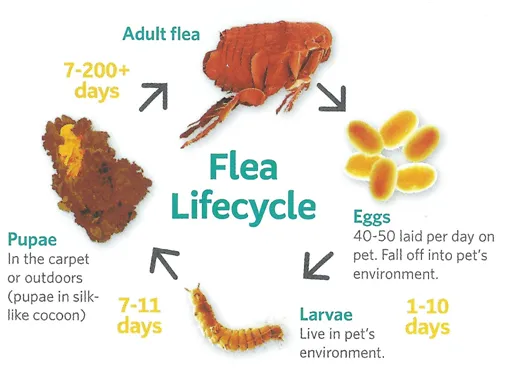If you have cats and dogs, odds are good you’ve thought about fleas every time your pet seems more itchy than usual, and with good reason! Fleas are a common external parasite here in Michigan. Many people think with our near-arctic winters we’d get a reprieve for at least half the year, but the fact is that fleas are a year-round concern. When it’s subzero outside, the fleas do the same thing as the rest of us… go inside! Once they’re inside, they make a home in your warm carpets, furniture, and, of course, on your pets. Though humans aren’t a flea’s preferred meal, they will even jump temporarily onto people and leave behind itchy bites.
Fleas can cause many problems for pets, including itching, hair loss, scabbing, and even anemia in severe cases. Fleas can also pass tapeworms (Dipylidium caninum) to both dogs and cats. Pets that are allergic to flea bites don’t even need to be harboring a colony of fleas to have skin problems – a single flea can jump on, bite the pet, and jump off, causing a chain allergic reaction that can last weeks to months if not addressed right away!
From Veterinary Partners dermatology team, here is a list of common flea myths vs. facts:
Myth: My pet cannot have fleas because he lives entirely indoors.
Fact: Fleas thrive particularly well in the well-regulated temperatures in the home.
Myth: My pet cannot have fleas because if there were any fleas they would be biting (insert name of a person in the family reportedly sensitive to flea bites). Since this person is not being bitten, there must not be any fleas.
Fact: The cat flea, Ctenocephalides felis, can suck the blood of a wide variety of animals. However, this flea definitely does not prefer human blood and won’t eat it unless absolutely necessary. Humans tend not to be bitten unless flea population numbers are high.
Myth: We do not have fleas because we only have hard wood floors.
Fact: Fleas love to develop in the cracks between the boards of hard wood floors.
Myth: My pet cannot have fleas because I would see them.
Fact: You cannot expect to see fleas because many animals will lick, groom, and chew after being bitten by a flea. This causes the flea to either jump off the pet or get swallowed.
As you can see, fleas are tricky little insects! There are ways to protect your pets from encountering these little bloodsuckers.
If you’re not currently seeing fleas or evidence of flea bites (itchy skin, hair loss - especially over near the base of your pet’s tail, scabs), starting your pet on a monthly flea preventive is a great step to ensure that your dog or cat remains flea-free.
There are many excellent products available. Here at Kalamazoo Animal Hospital, we prefer an oral product called Nexgard for dogs because it’s been proven safe and very effective. For cats, we like a topical called Revolution Plus. We also have had decent success with topical products for both dogs and cats with the active ingredient fipronil. A short-term product like Capstar can also be used to kill all the adult fleas currently on a pet, but this type of product only lasts a few hours and needs to be backed up with a product with a longer duration of action. We’d be happy to talk to you about the pros and cons of various products at your pet’s exam or during a phone call. Never, ever use a flea prevention product labeled for dogs on a cat – cats can have severe, life-threatening reactions to some of the ingredients used in dog-only products.
If you are seeing fleas or evidence of fleas, a monthly preventive is still a great starting point. Your pet may need a little more help though. If your pet is losing hair, has scabs or skin lesions, or just won’t stop itching, he or she may need additional medications to calm the inflammation and stop the allergic reaction. Sometimes, a secondary skin infection (like a staph bacteria, for example) can take advantage of irritated skin, and an antibiotic may be needed to resolve it. Contact us to set up an exam for your pet if you think your pet needs some help getting over the symptoms of fleas.
If your home has a flea infestation, you will also need to treat your home. There are a variety of home sprays that can be used or, for severe cases, a professional exterminator can even be contacted. Please contact us to discuss specific options. Regular vacuuming is also crucial to get fleas out and keep them from reproducing in your home.
Finally, once fleas have become a problem, it is imperative that you use an effective preventive for at least three consecutive months to fully break the flea life cycle. Using prevention for only a short time allows the fleas to come right back as new babies hatch and jump onto your now-unprotected pet. If your pet has had a flea infestation once, we strongly recommend being consistent with prevention 12 months a year to prevent a repeat performance.
Fleas are easily one of the most frustrating problems we encounter. They can make your pet miserable and can be difficult to eliminate once they’ve set up colonies in your home. Using prevention is the best way to make sure your pet will never have to deal with the itch and aggravation of fleas. Fleas are a problem that’s easy to prevent but much harder to cure.
As always, if you have questions about fleas, flea prevention, or if you think your pet has fleas, give us a call at 269-381-1570. We’re happy to help!



